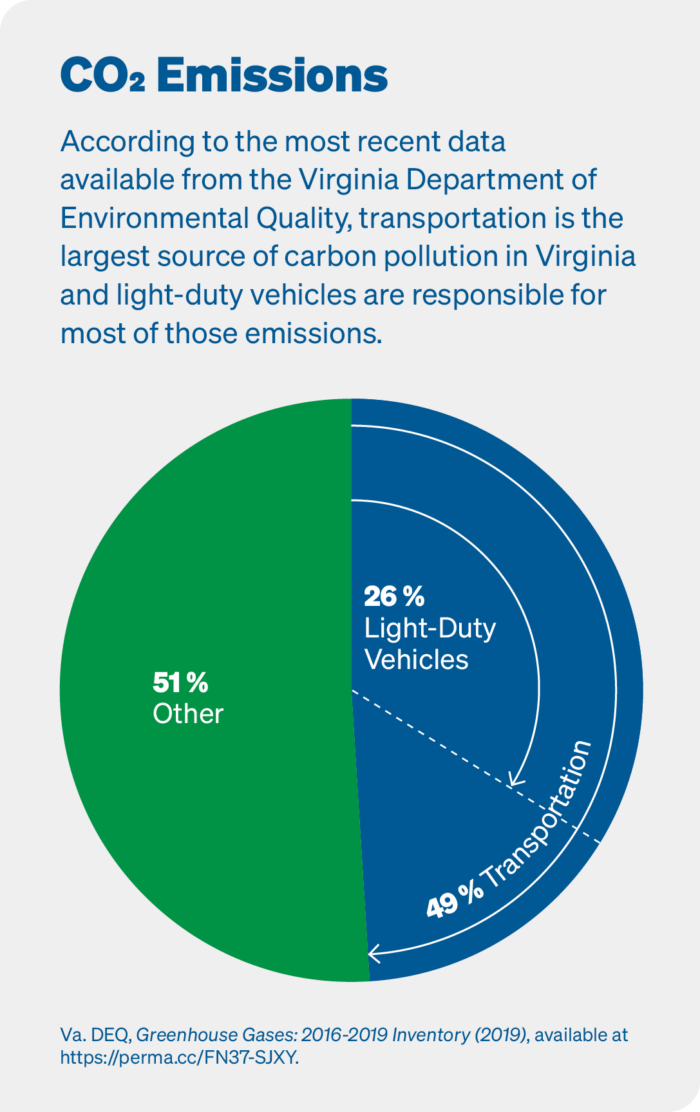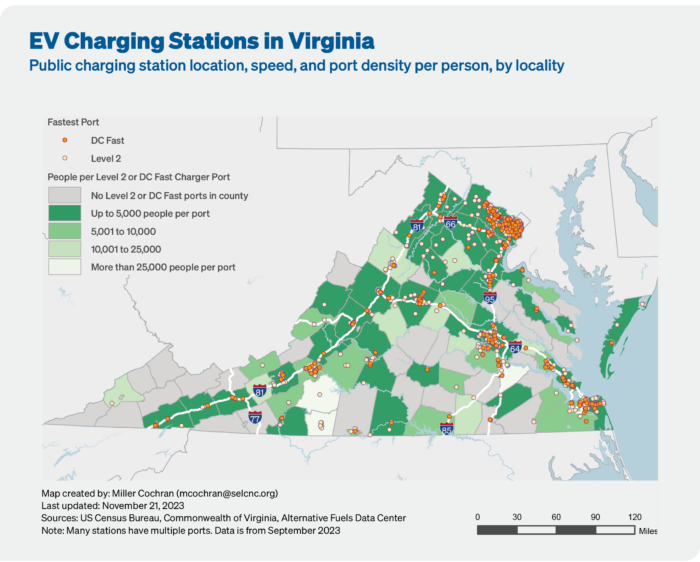Driving down pollution: Going electric in the South
Electric vehicles, or EVs, are good for the South. They are a key climate solution and are more affordable and available than ever before. In the coming years, even more drivers will experience the benefits of going electric.

In a new report, Driving Down Pollution: Accelerating Cleaner Cars in Virginia, SELC dives into the benefits Virginians will see with the implementation of the Clean Cars standards and how the transition to EVs will help tackle the problem of tailpipe pollution. Virginia—and the South—can and should accelerate the transition to EVs in an efficient and equitable way to bring the benefits of clean vehicles to communities throughout our region.
EVs are good for communities and the environment
Transportation is the largest source of climate-changing emissions throughout the South. Light-duty vehicles – the cars and trucks people drive everyday – are responsible for most of these emissions and produce other dangerous tailpipe emissions. Air pollutants and other toxic compounds from tailpipes harm our health and environment.
Substantial and rapid reductions in tailpipe pollution are needed to reduce the impacts of a changing climate and protect communities burdened by air pollution. While EVs won’t solve all the problems of auto dependence, they produce significantly less climate-changing emissions over the lifetime of a vehicle compared to internal combustion engines and emit zero tailpipe pollution.
“Reducing pollution from the vehicles that get us to work, school, and appointments every day is a key climate solution.” said Trip Pollard, leader of SELC’s Land and Community Program. “We need to accelerate policies and investments that will hasten the shift to cleaner vehicles.”
More drivers are choosing EVs in the South
Between 2016 and 2022, EV registrations across the South increased by over 640 percent, reflecting over 200,000 total registrations. This figure will increase significantly in the coming years.

Drivers are choosing EVs for good reasons. Not only are they fun to drive, but the typical EV driver will save between $6,000 and $12,000 over the lifetime of the vehicle compared to a gas-powered car thanks to reduced fuel and maintenance costs. Drivers have more choices than ever when looking for an EV that fits their lifestyle. Today, 74 battery electric and plug-in hybrid models are on the market, and this number will continue to grow since at least 15 manufacturers have promised to electrify a significant portion of their fleets by 2030.
The upfront costs of EVs also are declining. The price of many EV models is expected to reach parity with gas powered vehicles soon, and more used EVs are entering the market. New federal tax incentives make many EVs an even more affordable option and can help to reduce the purchase price as much as $7,500.
Building out our charging network
Currently, private charging infrastructure — chargers installed at homes, workplaces, and by businesses and governments to charge their vehicle fleets — dominates the EV charging market. An estimated 90% of EV drivers nationally can install charging infrastructure at home. Home charging will continue to be the most frequent and convenient way for most drivers to power up, but it’s no secret that “range anxiety” is a concern for many looking to switch to EVs.

Thankfully, the charging network continues to improve. There is currently more than $25 billion in public and private sector funding committed to build out the publicly available network nationwide. Key federal programs are just getting started, and drivers will see the charging network improve significantly in coming years. At SELC, we’re working to make sure that no one gets left behind as charging infrastructure is installed. We’ve weighed in with state and federal decisionmakers to help steer federal funding to great projects in our region, such as a recent award to install hundreds of EV chargers in Metro Atlanta.
Proactive planning for EVs lowers costs for everyone
There’s no question that widespread adoption of EVs will require more clean power and electrical infrastructure to power those vehicles. With the right policies in place, Southern states can meet their energy needs, reduce electricity bills, and even improve grid stability—all while curbing tailpipe pollution.
To capitalize on these benefits, we need smart policies like time-of-use rates, which can encourage drivers to plug in when power is cheap. The next generation of EVs can act as a distributed battery – drawing power from the grid when energy is abundant and sending power back when it is needed. And proactive planning and close scrutiny of proposed utility investments can keep costs in check. These and other efforts help put downward pressure on rates and will lead to utility bill savings for everyone, whether they drive an EV or not. SELC is advocating in utilities commissions across the South to urge adoption of policies that put people and the environment first.
Action is needed to accelerate the EV transition
All these developments are exciting, but the EV transition won’t happen overnight. Even if every new car sold starting today was electric, it would take decades for all cars on the road to be zero emission vehicles. There are many other steps we can take to accelerate the EV transition and make it as smooth and equitable as possible.
We are working to make sure that EVs are a convenient option for people across the South, and that transportation electrification benefits everyone, whether they choose to drive an EV or not.
Garrett Gee, Staff Attorney
For example, Virginia recently enacted a state law giving tenants the right to install a charger at home. This is a good first step, but without adequate wiring, electrical capacity, and other “make ready” infrastructure, home charging remains out of reach for many, especially renters. New homes should be required to be EV ready when they’re built, which would save thousands of dollars per home compared to the cost to retrofit later.
State and local governments across our region need to act to make charging easy and affordable for everyone, especially for people who live in apartment buildings and in rural areas. And with record levels of public and private investments in charging infrastructure, we must ensure that funding is spent wisely and that decisionmakers listen to communities on the ground.
“Accelerating the shift to EVs is key to cleaner air and fighting climate change, while saving families money,” said Garrett Gee, a staff attorney leading SELC’s transportation electrification work. “We are working to make sure that EVs are a convenient option for people across the South, and that transportation electrification benefits everyone, whether they choose to drive an EV or not.”

